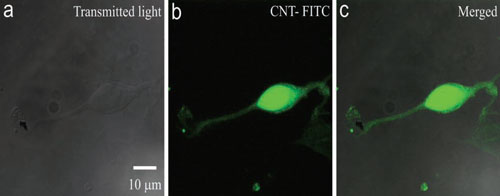| Posted: Jul 14, 2011 | |
Conflicting risk data complicates the use of carbon nanotubes as neural interfaces |
|
| (Nanowerk Spotlight) Carbon nanotubes (CNTs), like the nervous cells of our brain, are excellent electrical signal conductors and can form intimate mechanical contacts with cellular membranes, thereby establishing a functional link to neuronal structures. There is a growing body of research on using CNTs and other nanomaterials in neural engineering (see our Spotlight: "Nanotechnology to repair the brain"). If you want to read up on this topic, there also is an excellent review article on nanomaterials for neural interfaces. | |
| Scientists are already exploring the feasibility of using CNTs to probe neural activity (see for instance: "Nanotechnology listening device for neuronal talks"). With this research comes the need to develop a unified approach when assessing the toxicity of CNT in neurons, as a group of researchers write in a recent issue of Small ("Neurons Are Able to Internalize Soluble Carbon Nanotubes: New Opportunities or Old Risks?") | |
 |
|
| Bright field microscopy image (a), confocal microscopy image (b), and the merged images (c), show the ability of fluorescent multi-walled CNTs (2.5 µg mL-1) to internalize in cultured hippocampal neurons upon brief (2 hours) incubation time. Images courtesy of Jummi Lahisram and Mildred Quintana. (Reprinted with permission from Wiley-VCH Verlag) | |
| Given the often conflicting results of research reports on the biocompatibility of soluble CNT when administered to neurons in the central nervous system, Giada Cellot, Laura Ballerini, Maurizio Prato, and Alberto Bianco put together a review article that helps in clarifying which aspects (technical or methodological) of these studies may be responsible for their heterogeneous conclusions. | |
| As they write, a complex picture emerges from the reported data: is it feasible to develop CNT-based devices as drug delivery vectors? Ultimately, are soluble CNT neurotoxic, and, if yes, to what degree? | |
| "At the moment, we suggest that any definitive assessment of CNT neurotoxicity is hampered by methodological issues. Different production procedures for CNT exist; in addition these nano-objects possess variable dimensions, lengths, number of walls, degrees of purity, and metal content. To render CNT water-soluble, as preferably needed in biological applications, several approaches are available." | |
| An evaluation of the current literature is complicated by the fact that research reports often exclude detailed methodological features – but these can indeed have an impact in the biological effects of CNT. | |
| In a previous Nanowerk Spotlight we took a look at the state of carbon nanotube risk assessment ("Comparing apples with oranges - the problem of nanotubes risk assessment"): Despite their name, carbon nanotubes are not made of 100% carbon. Depending on which of the various synthesis techniques is used in their production, CNTs have variable chemistries and physical properties resulting from their different metal catalysts or amorphous carbon coatings. As a result, they may contain large percentages of metal and carbonaceous impurities which will have different environmental and toxicological impacts. | |
| In early toxicological studies, researchers obtained confounding results – in some studies nanotubes were toxic; in others, they were not. The apparent contradictions were actually a result of the materials that the researchers were using, not appreciating that 'carbon nanotubes' are really 'carbon nanotubes + metal + amorphous impurities'. Ignoring these impurities prohibits scientists from fully understanding the material's electronic character, environmental transport, transformation, and ecotoxicology. | |
| Scientists have begun to acknowledge – and the review paper by the Italian team elaborates on that – that the identity of these impurities and co-products is critical to CNTs' toxicology and chemical behavior. However, the chemical compositions of these fractions are not well defined and there have been no concerted efforts to identify and compile this information – without which accurate environmental risk assessments for specific CNT stocks is not possible. | |
| Concluding their review, the authors stress that scientists need to refer more to the physical and chemical characterization of the selected CNT, and they need to provide all relevant controls in order to avoid having misleading evaluations of risks reduce investments in emerging therapeutic strategies. Only this can lead to a unified approach in assessing the toxicity of CNT – critical for any future application in nanomedicine and biomedical areas. | |
 By
Michael
Berger
– Michael is author of three books by the Royal Society of Chemistry:
Nano-Society: Pushing the Boundaries of Technology,
Nanotechnology: The Future is Tiny, and
Nanoengineering: The Skills and Tools Making Technology Invisible
Copyright ©
Nanowerk LLC
By
Michael
Berger
– Michael is author of three books by the Royal Society of Chemistry:
Nano-Society: Pushing the Boundaries of Technology,
Nanotechnology: The Future is Tiny, and
Nanoengineering: The Skills and Tools Making Technology Invisible
Copyright ©
Nanowerk LLC
|
|
|
Become a Spotlight guest author! Join our large and growing group of guest contributors. Have you just published a scientific paper or have other exciting developments to share with the nanotechnology community? Here is how to publish on nanowerk.com. |
|
